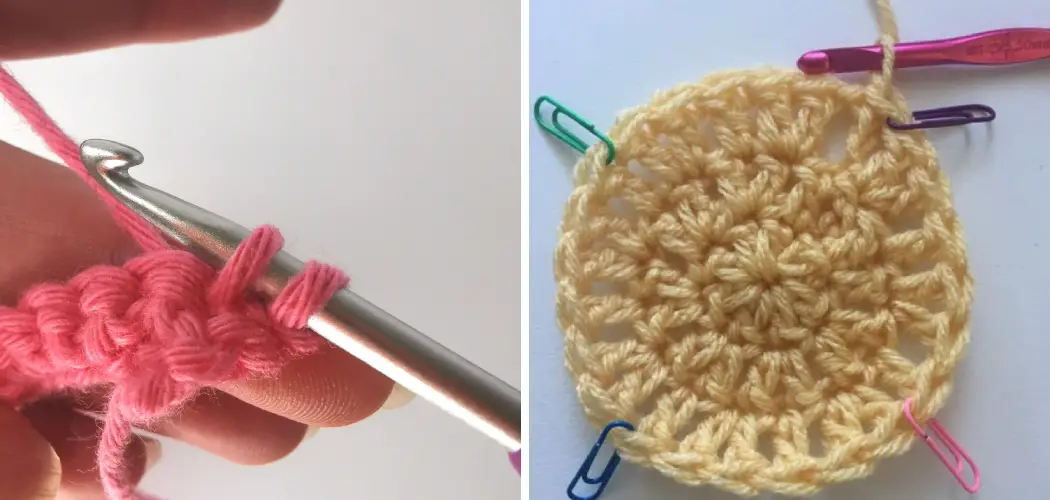Learning how to crochet is a classic hobby that both kids and adults can enjoy together. While it may initially seem intimidating, crocheting is a very approachable, even for young beginners. Repeating each stitch can be calming and meditative, helping kids and parents unwind after a long day. It also builds fine motor skills as their tiny fingers learn to manipulate the yarn and hook.

In this post, I’ll share some tips and tricks on how to teach kids to crochet. We’ll review the basic crochet stitches, how to hold the hook and yarn, select the right beginner project, and more.
By the end, your little one will be well on their way to making their very first scarf, hat, or amigurumi toy with you by their side.
What Will You Need?
Before diving into the steps, having all the necessary materials on hand is essential. Here are some things you’ll need to teach your kids how to crochet:
- A crochet hook (size H/5mm is recommended for beginners)
- Yarn (worsted weight is an excellent place to start)
- Scissors
- Tapestry needle (for weaving in ends)
- A comfortable and well-lit workspace
It’s also helpful to have a crochet cheat sheet or reference book handy for both you and your child to use as a guide.
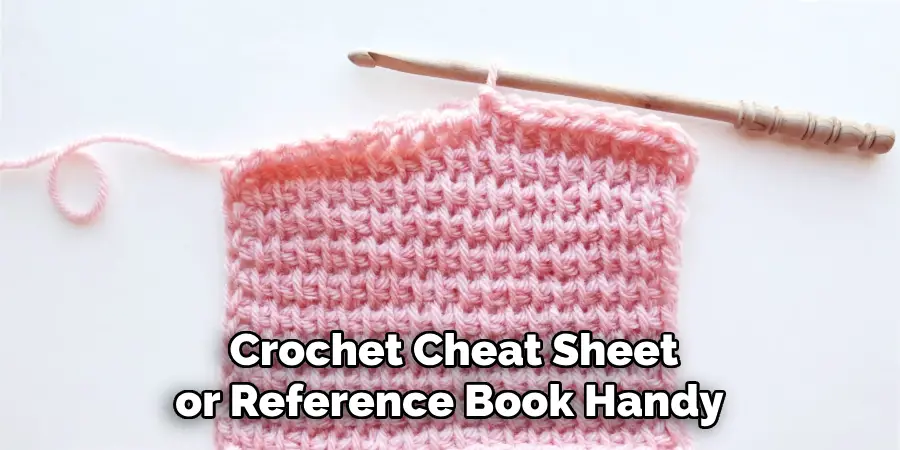
10 Easy Steps on How to Teach Kids to Crochet
Step 1. Gather Materials
You’ll need to gather the necessary materials before you can teach your kids to crochet. This includes a crochet hook, yarn, and a pair of scissors. It’s also helpful to have a stitch marker or counter handy so your kids can easily keep track of their stitches. Once you have all the materials gathered, it’s time to start teaching!
Step 2. Learn Basic Stitching Techniques
The first step in teaching your kids how to crochet is to teach them the basic stitching techniques. Start by showing them how to make a slip knot and chain stitch, then move on to single crochet and double crochet stitches. Make sure they understand each technique before you move on to the next one.
Step 3. Practice Makes Perfect
Once your kids have learned the basics of crocheting, they need to practice to perfect their skills. Encourage them to practice regularly and help them troubleshoot any issues they may encounter. You can also provide them with simple patterns or projects they can work on as they gain more experience with crocheting.
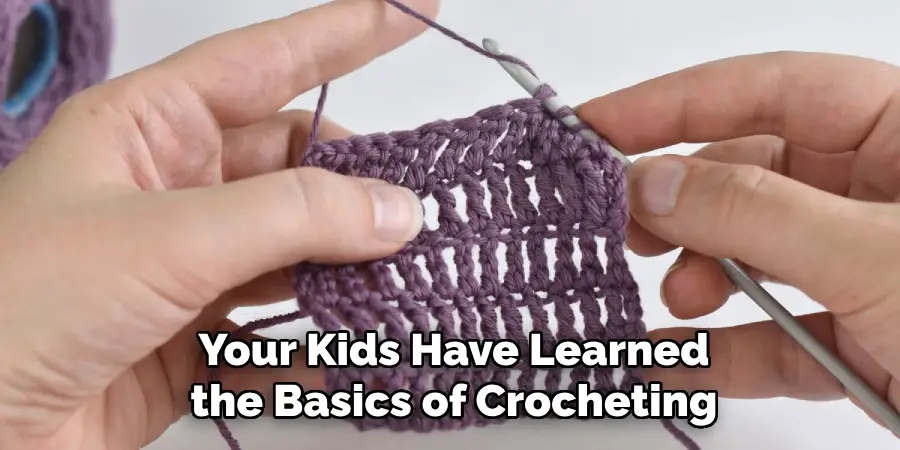
Step 4. Start with a Simple Project
After they are comfortable with the basics, it’s time to start a beginner-friendly project. A scarf is an excellent choice because it only requires knowledge of the basic stitches and is a relatively straightforward project.
Start by helping them create a foundation chain that is the desired width of the scarf, then guide them through adding rows until they reach the desired length. This project allows them to practice their new skills and leads to a tangible result – an item they made themselves, which can boost their confidence and enthusiasm for crocheting.
Step 5. Encourage Creativity
As your children become more comfortable with the basic stitches and have successfully completed their first project, encourage them to explore their creativity. Introduce them to new patterns or allow them to experiment with different yarn colors and textures.
They could try making a crochet flower, a small pouch, or even a tiny amigurumi creature. This will not only keep the learning process enjoyable, but also allow them to discover their own unique style and preferences in crocheting.
Step 6. Be Patient and Supportive
Teaching kids to crochet, or any new skill for that matter, requires a great deal of patience. It’s important to remember that everyone learns at their own pace. Your child may grasp some concepts quickly while others may pose a challenge. In these situations, it’s crucial to stay patient and offer your support.
Praise their efforts, not just their results, and reassure them that it’s okay to make mistakes. This will create a positive learning environment and help your child develop a love for crocheting.
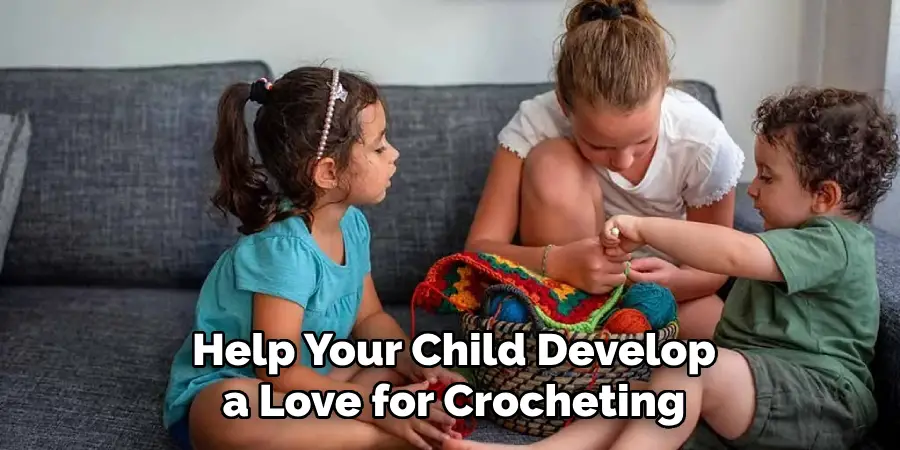
Step 7. Reinforce Learning with Fun Projects
To keep your kids engaged in learning how to crochet, it’s a good idea to reinforce this new skill with fun, age-appropriate projects. For younger children, consider simple projects like creating a colorful coaster or a playful headband.
For older kids, more complex items like a cute amigurumi animal or a fashionable bag may appeal more. Remember, the goal is to teach crocheting and make it a fun experience for your kids. This will help them to associate learning new skills with positive experiences, making them more likely to continue exploring and learning new things.
Step 8. Teach Them to Fix Mistakes
An important part of learning how to crochet is understanding how to fix mistakes. Instead of correcting your child’s work yourself, guide them through identifying and fixing their errors. This can include unraveling stitches (known as “frogging”), picking up dropped stitches, or countering extra stitches.
Learning to fix mistakes will foster a sense of autonomy in your child and teach them that it’s okay to make mistakes as they’re a natural part of the learning process.
Step 9. Celebrate Achievements
Crocheting is a skill that requires patience and attention to detail. It’s essential to celebrate your child’s achievements, no matter how small. Whether they’ve mastered a new stitch, completed a project, or simply spent a dedicated amount of time practicing, acknowledge their effort.
Positive reinforcement can motivate your child to continue learning and enjoy crocheting. This can also aid in boosting their self-confidence and developing a growth mindset.

Step 10. Continue Learning and Growing
After mastering the basics and completing initial projects, encourage your kids to continue learning and growing in their crocheting journey. Introduce them to new techniques, stitches, and patterns as they progress. You could explore tutorials online, join crochet clubs, or even attend workshops.
This continuous learning will improve their skills and open them to a community of fellow crochet enthusiasts. Remember, the journey of crocheting is a marathon, not a sprint. It’s about the joy of creating and the satisfaction of seeing a project through from start to finish.
By following these steps and incorporating patience, creativity, and encouragement, you can successfully teach your kids how to crochet. It’s a skill that provides a creative outlet and helps develop fine motor skills, concentration, and patience.
5 Additional Tips and Tricks
- Start With the Basics: Before diving into complex patterns, ensure kids understand the basic stitches such as chain stitch, single crochet, and double crochet. This solid foundation will make future learning much more accessible.
- Use Larger Hooks and Thicker Yarn: These are easier for little hands to manage and help children see their stitches more clearly.
- Be Patient and Encouraging: Children may wait to pick up crocheting. It is essential to be patient and offer positive reinforcement to keep them motivated.
- Make It Fun: Incorporate their interests into the projects. For example, if they love animals, start with a simple crochet animal pattern.
- Practice Regularly: Like any other skill, practice makes perfect. Allocate a specific time each day for crocheting to help children develop their skills and keep their interest alive.
With these tips and tricks, teaching kids to crochet can be a breeze. Remember that it is important to make the learning experience fun and rewarding for children.
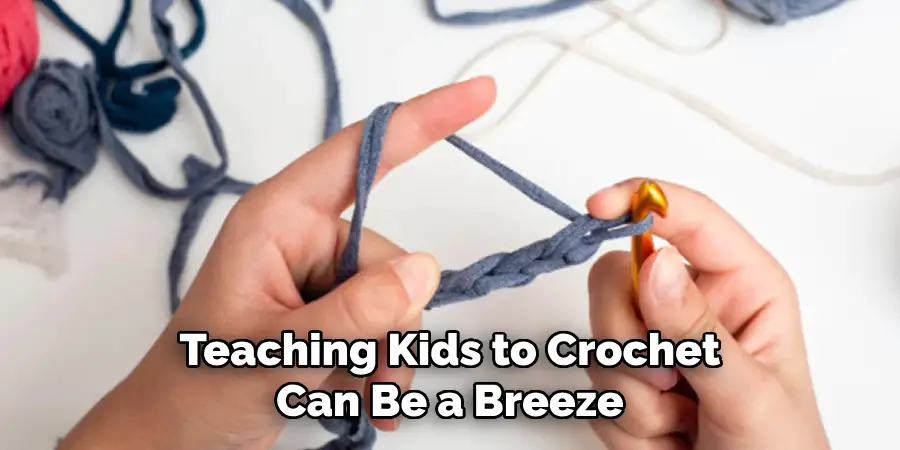
5 Things You Should Avoid
- Avoid Rushing the Learning Process: Remember that crocheting is a complex skill that takes time to master. Try not to rush children into taking on projects beyond their skill level.
- Avoid Negative Comments: It’s essential to keep the learning environment positive. Avoid criticizing mistakes and, instead, help kids learn from them.
- Avoid Using Thin, Dark Yarn Initially: Dark colors make it hard to see stitches, and thin yarn can be tricky for beginners to handle. Stick to light-colored, thicker yarn at first.
- Avoid Long Initial Sessions: Kids might lose interest if the sessions are shorter. Keep it short, fun, and frequent.
- Avoid Skipping Safety Instructions: Crocheting involves sharp tools. Ensure that safety is a priority, and avoid assuming kids know how to handle crochet tools safely.
By avoiding these pitfalls, you can create a safe and positive learning environment to help children develop crocheting skills.
5 Easiest Design Patterns for Kids
- Granny Squares: This classic pattern is perfect for beginners. It involves repeating the same stitch multiple times, making it easy to learn and quick to complete.
- Amigurumi: These small stuffed toys are fun and relatively easy to make. Children will love creating cute animals or characters with this design.
- Headbands: Use a simple stitch like a single or half-double crochet to make a stylish accessory for kids.
- Tissue Box Cozies: These fun and whimsical covers are perfect beginner projects, as they involve basic stitches and provide immediate gratification upon completion.
- Fingerless Gloves: A practical and stylish project that introduces children to more
- Teaching Other Skills: Crocheting can be a great way to teach other skills, such as math and pattern recognition. Encourage kids to create patterns with different combinations of stitches, or count the number of stitches in a row.
By avoiding these pitfalls, you can create a safe and positive learning environment to help children develop crocheting skills.
Is Crochet or Knitting Easier for Kids?
The answer to this question is subjective and ultimately depends on the child’s preferences. Some kids may find crochet easier because it involves using one hook instead of two needles, which can be more manageable for small hands. Others may prefer knitting because it allows for more intricate designs and patterns. Letting children try both and see which they enjoy more is important.
Ultimately, the most critical aspect is that kids have fun and enjoy the learning process. Crocheting can be a wonderful hobby for kids to explore their creativity and express themselves while also developing valuable skills.
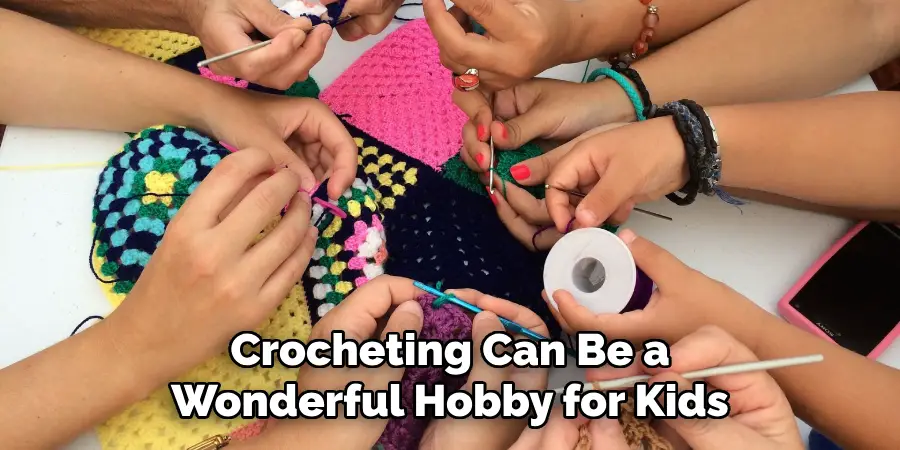
With patience, encouragement, and these tips and tricks, you can successfully teach your kids how to crochet and open up a world of possibilities.
Why is Your Crochet Gauge Not Enough Rows?
Gauge is an essential aspect of crocheting that refers to the number of stitches and rows per inch in a crochet project. It helps ensure that the finished project matches the size specified in a pattern. If you need more than your crochet gauge, you create fewer rows than required for your project.
There are several reasons why you may be experiencing this issue:
- Tension: Tension is the pressure you apply to your yarn while crocheting. If your tension is too tight, it can result in fewer rows than specified in the pattern.
- Yarn and Hook Size: The size of your hook and yarn will affect your gauge. Using a smaller hook or thicker yarn can result in fewer rows.
- Stitch Memory: Some stitches stretch or shrink over time, affecting your gauge. To avoid this, you can block your project after completion to ensure it maintains its intended size.
To troubleshoot and fix your crochet gauge issues, try adjusting your tension, using the recommended hook and yarn size in the pattern, or blocking your finished project. Remember, practice makes perfect, and with time and experience, you will be able to achieve your desired gauge consistently. So keep practicing and have fun teaching kids the joy of crocheting!
Conclusion
As we’ve seen, there are many creative and inspiring ways on how to teach kids to crochet . You can start by introducing the tools and supplies for them to learn with, such as lightweight needles, hook, yarn, and other materials. Then, you’ll need a crafty lesson plan and teach the basics in a fun way – like using colorful yarns with simple terms and talking through the different techniques.
Finally, provide time for practice by encouraging your children to create something unique with their newfound skills. Most importantly, remember to have some patience; remember that the most important tools your child needs are motivation, practice – and a lot of love. With a little bit of guidance from you their teacher, they can create something beautiful while learning an enjoyable skill they can use for years to come.
So why not give it a try? Go get started on teaching your kids how to crochet!
Expertise:
Crafting expert with a focus on innovative techniques and diverse materials.
Specialization:
- Textile arts (weaving, embroidery, and fabric dyeing)
- Woodworking and furniture design
- Mixed media and upcycling projects
Recognition:
- Featured in local art exhibits showcasing innovative craft projects
- Collaborated with community organizations to promote crafting workshops
- Received accolades for contributions to sustainable crafting initiatives
Mission:
- To inspire and empower crafters of all levels to discover their creative potential
- Encourages experimentation and self-expression through hands-on projects

